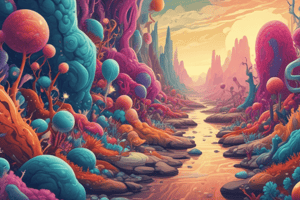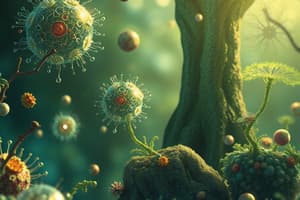Podcast
Questions and Answers
What is the main function of flagella in bacteria?
What is the main function of flagella in bacteria?
- Mobility (correct)
- Nutrient absorption
- Attachment to surfaces
- Protection against environmental changes
What characteristic distinguishes gram positive bacteria from gram negative bacteria?
What characteristic distinguishes gram positive bacteria from gram negative bacteria?
- Containment of toxic lipids
- Presence of outer membrane
- Staining pink-red
- Thick peptidoglycan layer (correct)
Why are certain antibiotics ineffective against gram negative bacteria?
Why are certain antibiotics ineffective against gram negative bacteria?
- Ability to rapidly metabolize antibiotics
- Additional outer membrane acting as a barrier (correct)
- Thick cell wall preventing penetration
- Presence of ribosomes that absorb antibiotics
What is the role of pili or fimbriae in bacteria?
What is the role of pili or fimbriae in bacteria?
What happens to the bacterial cell wall when water moves into the cell?
What happens to the bacterial cell wall when water moves into the cell?
Which of the following statements about endospores is correct?
Which of the following statements about endospores is correct?
Which type of bacteria is characterized by a spherical shape and can exist in clusters?
Which type of bacteria is characterized by a spherical shape and can exist in clusters?
What is the primary reason viruses are not considered living organisms?
What is the primary reason viruses are not considered living organisms?
What is a primary function of microorganisms in ecosystems?
What is a primary function of microorganisms in ecosystems?
What is the first step in the process of viral replication?
What is the first step in the process of viral replication?
Which of the following foods is NOT produced using microorganisms?
Which of the following foods is NOT produced using microorganisms?
Which bacterial shape is described as rod-shaped?
Which bacterial shape is described as rod-shaped?
What characteristic distinguishes prokaryotic cells from eukaryotic cells?
What characteristic distinguishes prokaryotic cells from eukaryotic cells?
What structural feature do some viruses have that aids in attachment to host cells?
What structural feature do some viruses have that aids in attachment to host cells?
Which structure in bacteria serves as protection from dehydration?
Which structure in bacteria serves as protection from dehydration?
In what type of environment do most bacteria thrive regarding pH levels?
In what type of environment do most bacteria thrive regarding pH levels?
How do microorganisms contribute to human health?
How do microorganisms contribute to human health?
Which of the following statements about the structure of typical bacteria is incorrect?
Which of the following statements about the structure of typical bacteria is incorrect?
What is the main function of the spore coat surrounding endospores?
What is the main function of the spore coat surrounding endospores?
Which of the following correctly describes the process of binary fission in bacteria?
Which of the following correctly describes the process of binary fission in bacteria?
Which pair correctly identifies the structure of a bacterial name?
Which pair correctly identifies the structure of a bacterial name?
What environmental condition is most important for the optimal growth of pathogenic bacteria?
What environmental condition is most important for the optimal growth of pathogenic bacteria?
Which statement accurately reflects the durability of endospores?
Which statement accurately reflects the durability of endospores?
What is the initial step in the binary fission process?
What is the initial step in the binary fission process?
What is a characteristic feature that distinguishes fungi from animal cells?
What is a characteristic feature that distinguishes fungi from animal cells?
In what type of environment are many fungi capable of thriving?
In what type of environment are many fungi capable of thriving?
How do yeasts primarily reproduce?
How do yeasts primarily reproduce?
Which of the following conditions can lead to an increase in pathogenic behavior of C. albicans?
Which of the following conditions can lead to an increase in pathogenic behavior of C. albicans?
What is the typical localization of human fungal infections?
What is the typical localization of human fungal infections?
How do moulds reproduce?
How do moulds reproduce?
What is a characteristic property of protozoa?
What is a characteristic property of protozoa?
Which of the following is NOT true about protozoa?
Which of the following is NOT true about protozoa?
How do protozoa primarily obtain nutrients?
How do protozoa primarily obtain nutrients?
What distinguishes prions from other microorganisms?
What distinguishes prions from other microorganisms?
Which of the following diseases is caused by a pathogenic protozoan?
Which of the following diseases is caused by a pathogenic protozoan?
What is the role of cysts formed by protozoa?
What is the role of cysts formed by protozoa?
Which statement about prions is accurate?
Which statement about prions is accurate?
Which structure is absent in protozoa?
Which structure is absent in protozoa?
What happens to a normal protein when it becomes a prion?
What happens to a normal protein when it becomes a prion?
What is a common habitat for protozoa?
What is a common habitat for protozoa?
Flashcards are hidden until you start studying
Study Notes
Importance of Microorganisms
- Microorganisms are vital for ecosystem function; they decompose organic matter, recycling nutrients into the soil.
- They play critical roles in food chains and are involved in the production of various foods including bread, yogurt, cheese, and alcoholic beverages.
- Beneficial associations with plants and animals include normal flora that helps prevent pathogenic infections and gut bacteria that aid digestion.
- Utilized in industries for drug production (like antibiotics) and scientific research tools.
Structure of Bacteria
- Prokaryotic cells lacking a nucleus, instead have a nucleoid containing genetic material.
- Present structures include ribosomes, cell membrane, and cell wall, with some having capsules for protection.
- Bacteria may possess flagella for movement and pili for attachment to surfaces.
Bacterial Cell Wall
- Provides mechanical support to prevent cell lysis due to osmotic pressure.
- Composed mainly of peptidoglycan; determines classification as gram-positive (purple stain, thick peptidoglycan) or gram-negative (pink stain, thin peptidoglycan plus outer membrane).
- The outer membrane of gram-negative bacteria acts as a barrier to antibiotics and contains lipopolysaccharides that can induce fever.
Endospores
- Certain bacteria form endospores in unfavorable conditions, allowing survival during extremes like heat and desiccation.
- Endospores are resistant to adverse effects from heat, chemicals, or radiation and can remain dormant for years.
Bacterial Reproduction
- Bacteria reproduce through binary fission, involving the duplication of genetic material and division into two identical cells.
Nomenclature of Bacteria
- Two-part naming system: the genus name (first) and species name (second), both italicized (e.g., Escherichia coli).
- Can be abbreviated to the first letter of the genus and full species name (e.g., E. coli).
Requirements for Bacterial Growth
- Nutrients needed, particularly carbon for cellular structures.
- Optimal growth conditions include:
- Temperature affects reproduction rates; pathogenic bacteria thrive at 37°C.
- Oxygen requirements vary; some need oxygen, while others thrive in anaerobic conditions.
- Prefer neutral pH environments and adequate moisture for reproduction.
Shapes of Bacteria
- Cocci: spherical (e.g., staphylococci - clusters, streptococci - chains).
- Bacilli: rod-shaped bacteria.
- Vibrio: curved rod-shaped.
- Spirilla: spiral-shaped.
Structure of Viruses
- Viruses are smaller than bacteria, not observable under light microscopes.
- Composed of nuclear material within a protein coat (capsid); some possess an outer envelope that mimics the host cell membrane.
- Non-living entities that cannot reproduce or perform metabolism outside of a host cell.
Viral Replication Process
- Attachment to host cell, penetration of viral material, uncoating of capsid, synthesis of viral material, assembly of new viruses, and release via lysis of the host cell or budding.
Fungi Overview
- Diverse organisms including unicellular yeasts and multicellular moulds; some are human pathogens.
- Structural features include a nucleus, organelles, and cell walls (unlike animal cells).
- Can thrive in low moisture and low pH environments; larger than bacteria.
Fungal Infections
- Typically localized; systemic infections can be severe.
- Examples include Tinea pedis (athlete's foot) and Candida albicans (thrush).
- Susceptibility may increase when host defenses are weakened or normal flora is disrupted.
Reproduction of Fungi
- Yeasts reproduce by budding, producing a daughter cell.
- Moulds reproduce via spores, enabling survival and propagation.
Importance of Microorganisms
- Microorganisms play a crucial role in decomposition, recycling nutrients back into the soil.
- Essential in ecological food chains and interactions.
- Utilized in food production: examples include mushrooms, bread, yogurt, cheese, beer, and wine.
- Beneficial associations with flora and fauna: normal flora prevents disease-causing microbes; gut bacteria aid in digestion.
- Industrial applications: production of drugs (e.g., antibiotics) and useful chemicals (e.g., food additives), also vital in scientific research.
Structure of Typical Bacteria
- Bacteria are prokaryotic cells; lack a nucleus, containing nucleoid instead.
- Possess ribosomes but no other organelles.
- Have a cell membrane and a protective cell wall.
- Capsule protects from dehydration; flagella provide mobility.
- Pili or fimbriae assist in adhering to surfaces.
Bacterial Cell Wall
- Offers mechanical support preventing cell lysis from water influx.
- Composed mainly of peptidoglycan.
- Classified as gram-positive (purple stain, thick peptidoglycan layer) or gram-negative (pink/red stain, thin peptidoglycan with an outer membrane).
- Outer membrane of gram-negative bacteria serves as a barrier against certain antibiotics.
- Contains lipopolysaccharides that can trigger host immune responses, leading to fever or shock.
Endospores
- Some bacteria form endospores under unfavorable conditions for survival.
- Endospores are extremely resistant to harsh conditions, including heat, chemicals, and radiation.
- Can remain dormant but viable for years.
Reproduction of Bacterial Cells
- Bacteria reproduce through binary fission.
- Process includes duplicating genetic material, moving chromosomes, and forming two identical cells.
Nomenclature of Bacteria
- Bacteria have a binomial nomenclature: genus name (first) and species name (second).
- Names are italicized or underlined; can be abbreviated (e.g., S. aureus, E. coli).
Bacterial Growth Requirements
- Require essential nutrients, especially carbon for cellular structure.
- Favorable environmental conditions include:
- Optimal temperature (37°C for pathogens).
- Varying oxygen requirements; some thrive in oxygen-rich environments, while others prefer low oxygen.
- Neutral pH is generally suitable.
- Sufficient moisture is needed for reproduction.
Shapes of Bacteria
- Coccus: spherical shape.
- Staphylococci: clusters of cocci.
- Streptococci: chains of cocci.
- Bacillus: rod-shaped.
- Vibrios: curved, rod-shaped.
- Spirilla: spiral-shaped.
Structure of a Virus
- Viruses are smaller than bacteria, requiring electron microscopy for visualization.
- Composed of nuclear material encased in a protein coat (capsid), may have an additional envelope.
- Have spikes on their surface for attachment to host cells.
- Lack ribosomes and organelles, unable to metabolize or reproduce outside a host cell.
Viral Replication Process
- Attachment to host cell initiates infection.
- Viral material penetrates the host cell and is uncoated.
- Host's cellular machinery synthesizes new viral components.
- Newly formed viruses assemble and are released, often killing the host cell.
Protozoa
- Eukaryotic, single-celled organisms, primarily found in aquatic environments.
- Some act as parasites in animals; most do not cause serious illness.
- Capable of forming cysts for survival in abrasive conditions.
- Pathogenic examples include Giardia intestinalis (Giardiasis) and Plasmodium species (Malaria).
Structure of Protozoa
- Contain a nucleus and cell organelles; lack a cell wall.
- Various forms of movement (flagella, pseudopodia, cilia).
- Obtain nutrients primarily through phagocytosis or membrane absorption.
Prions
- Non-cellular microorganisms; mutated proteins.
- Abnormal form leads to prion diseases.
- Accumulation in brain tissues results in degeneration of nervous tissue.
Studying That Suits You
Use AI to generate personalized quizzes and flashcards to suit your learning preferences.



